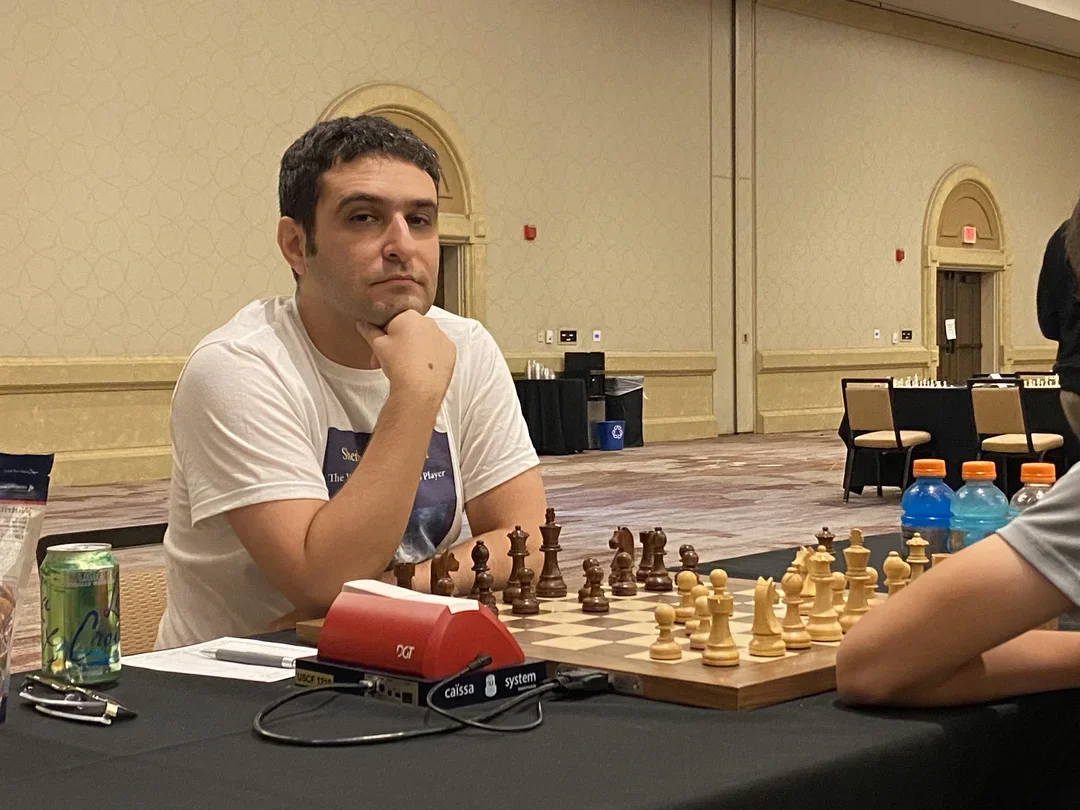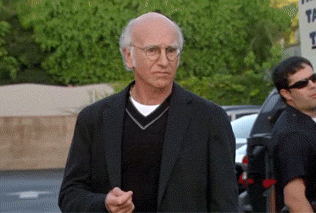One of the best things about the U.S. Open is that it is one section. No masters and above section, and no U1600 group — instead, it’s all-play-all, with the result that in the early rounds, some amateur players get to take shots at much stronger competition. I know this firsthand, as I got to play GM Alexander Shabalov in two consecutive U.S. Open first rounds. (You can guess how it went.)
GM Elshan Moradiabadi was the only GM in the nine-day schedule for this year’s U.S. Open, and he was nearly 350 points higher rated than the second player on the list, IM Timothy Taylor. This is not an unalloyed good. On the one hand, Moradiabadi “should” have been able to run the table against weaker opposition, taking a perfect score into the merge without much difficulty.

On the other hand, he actually had to do it. And anyone who plays lower rated competition regularly knows that, sometimes, things just don’t go according to plan.
I thought it would be interesting to take a look at Moradiabadi’s first six games in Rancho Mirage, and try to discover whether there was something to be learned from them. Just how does a strong player go about defeating lesser-rated opponents? And what can we chess mortals do to maximize our chances against titled players?
Let’s go round-by-round and examine the games.
Round 1: Black versus Lawrence Reifurth (1700)
After a sixth move inaccuracy that Reifurth did not take advantage of, Moradiabadi got a good position out of the opening. Two inconsistent moves were all the GM needed to launch an irresistible attack on the white king, and the game was over after 19 moves.
Lesson: Play with purpose and be ready to take advantage of an unwary GM in the opening. This game is proof that sometimes even they make move order mistakes.

Round 2: White versus Anthony Hung (1948)
Here we see the GM positionally outplaying the amateur player. Using his knowledge of Capablanca – Treybal (Karlsbad, 1929) as a guide, Moradiabadi conjures an overwhelming space and mobility advantage where Black’s light-squared bishop is a prisoner behind its pawns.
But even GMs overlook things. And Hung made things difficult after the breakthrough 26. b5! with the well-calculated 31. ... Bc6!. Fortunately for Moradiabadi there was a resource, ensuring that the full point was not thrown away.
Lesson: Know the classics. They’re classic for a reason. And don’t lose all hope if you’re in a tough position. Hung fought well and found some tricky moves to make the top seed’s life difficult.
Here’s the Capablanca – Treybal game; if you don’t know it, you should!
Round 3: Black versus Matthew Ng (2036)
Ng’s unambitious opening was rewarded when play got dynamic and both sides had chances. The story, however, is an old one: the GM took his chances, while the expert did not. And six or so moves after the missed opportunity, White’s pieces were jumbled and ripe for tactics.
Lessons: Don’t be afraid to shoot your shot! What’s the worst that can happen?
Round 4: White versus Saif Shawkat (2106)
A cramped position without counterplay is a recipe for trouble against stronger players. Here, Moradiabadi took the space and the material he was offered and suffocated his opponent. Note the way that the knights make use of the space advantage and the holes in Black’s pawn structure.
Lesson: Quiet suffering rarely works against stronger players. Try to make a mess — they miss things too!
Round 5: Black versus John Luger (2026)
Moradiabadi’s “rope-a-dope” strategy nearly got him into trouble in round five. Essaying the Hippo with Black, Luger played solidly, forcing the GM to take some chances to complicate the position. But Luger missed his moment to take it to the top seed, instead draining the tension from the position for a pawn. The black pieces came to life while White tried to consolidate the material, and soon Moradiabadi overwhelmed his opponent.
Lesson: Amateurs hate tension-filled positions. Learn to love them! And beware of Iranian-American GMs bearing gifts — sometimes a pawn isn’t worth the trouble that comes with it.

Round 6: White versus Austin Mei (2265)
Not much to see here: Black got a little carried away, improperly giving the queen for two bishops, after which the GM was willing to give a bit of the material back to reach a risk-free winning position.
Lesson: curb your enthusiasm?

Summary
In these games we saw players commit a few different sins against Cäissa — passivity, failure to punish errors, inattention to critical moments, and releasing the tension without good reason.
But the amateurs weren’t the only ones erring in these games. Moradiabadi also had his share of slips, but the difference was that (a) his were usually more subtle, and (b) he didn’t fail to take advantage of the errors made by his opponents. He certainly knew more patterns than his opponents (see game two), and when to apply them, but in a messy position like we saw in the fifth round, anything can — and nearly did! — happen.
So, in summary, grandmasters are very, very strong, but they’re human. They make mistakes just like you or I do... just fewer of them. If you get the chance to take on a GM, whether it be in a simul, online, or in the first round of the U.S. Open, think of it as a freeroll for you to test yourself. Play your best chess, take your shot, and enjoy the ride!
Categories
Archives
- January 2026 (4)
- December 2025 (27)
- November 2025 (29)
- October 2025 (39)
- September 2025 (27)
- August 2025 (29)
- July 2025 (43)
- June 2025 (25)
- May 2025 (24)
- April 2025 (29)
- March 2025 (29)
- February 2025 (20)
- January 2025 (24)
- December 2024 (34)
- November 2024 (18)
- October 2024 (35)
- September 2024 (23)
- August 2024 (27)
- July 2024 (44)
- June 2024 (27)
- May 2024 (31)
- April 2024 (51)
- March 2024 (34)
- February 2024 (25)
- January 2024 (26)
- December 2023 (29)
- November 2023 (26)
- October 2023 (37)
- September 2023 (27)
- August 2023 (37)
- July 2023 (47)
- June 2023 (33)
- May 2023 (37)
- April 2023 (45)
- March 2023 (37)
- February 2023 (28)
- January 2023 (31)
- December 2022 (23)
- November 2022 (32)
- October 2022 (31)
- September 2022 (19)
- August 2022 (39)
- July 2022 (32)
- June 2022 (35)
- May 2022 (21)
- April 2022 (31)
- March 2022 (33)
- February 2022 (21)
- January 2022 (27)
- December 2021 (36)
- November 2021 (34)
- October 2021 (25)
- September 2021 (25)
- August 2021 (41)
- July 2021 (36)
- June 2021 (29)
- May 2021 (29)
- April 2021 (31)
- March 2021 (33)
- February 2021 (28)
- January 2021 (29)
- December 2020 (38)
- November 2020 (40)
- October 2020 (41)
- September 2020 (35)
- August 2020 (38)
- July 2020 (36)
- June 2020 (46)
- May 2020 (42)
- April 2020 (37)
- March 2020 (60)
- February 2020 (38)
- January 2020 (45)
- December 2019 (34)
- November 2019 (35)
- October 2019 (42)
- September 2019 (45)
- August 2019 (56)
- July 2019 (44)
- June 2019 (35)
- May 2019 (40)
- April 2019 (48)
- March 2019 (61)
- February 2019 (39)
- January 2019 (30)
- December 2018 (29)
- November 2018 (51)
- October 2018 (45)
- September 2018 (29)
- August 2018 (49)
- July 2018 (35)
- June 2018 (31)
- May 2018 (39)
- April 2018 (31)
- March 2018 (26)
- February 2018 (33)
- January 2018 (30)
- December 2017 (26)
- November 2017 (24)
- October 2017 (30)
- September 2017 (30)
- August 2017 (31)
- July 2017 (28)
- June 2017 (32)
- May 2017 (26)
- April 2017 (37)
- March 2017 (28)
- February 2017 (30)
- January 2017 (27)
- December 2016 (29)
- November 2016 (24)
- October 2016 (32)
- September 2016 (31)
- August 2016 (27)
- July 2016 (24)
- June 2016 (26)
- May 2016 (19)
- April 2016 (30)
- March 2016 (36)
- February 2016 (28)
- January 2016 (32)
- December 2015 (26)
- November 2015 (23)
- October 2015 (16)
- September 2015 (28)
- August 2015 (28)
- July 2015 (6)
- June 2015 (1)
- May 2015 (2)
- April 2015 (1)
- February 2015 (3)
- January 2015 (1)
- December 2014 (1)
- July 2010 (1)
- October 1991 (1)
- August 1989 (1)
- January 1988 (1)
- December 1983 (1)







